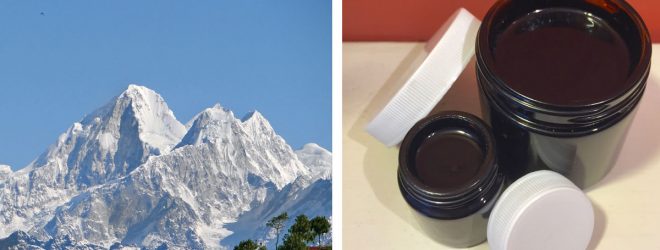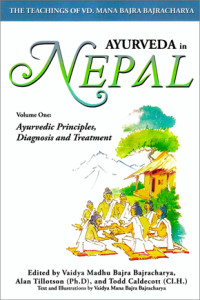One of the emerging health food trends to hit the Western world is the consumption of Shilajit, a curious resin found exuding from the steep rock faces of certain mountains in the Himalayas. It is one of the more unique remedies utilized in traditional medicine, and for practitioners of the ancient system of medicine called Ayurveda, among the most valuable as well. It is a relatively rare substance, found only when the hot summer sun beats down upon the mountains, causing the resin to liquefy and exude from cracks in the rocks. Similar exudates are also found in other mountain ranges, including the mumiyo harvested from the Altai Mountains in Siberia, but these are not necessarily the same thing as Shilajit.

What is Shilajit?
As the older scientific names of ‘bitumen’ and ‘ashphaltum’ suggest, Shilajit was once thought to be some sort of fossilized organic material. It was believed to be derived from decaying organic materials that built up along the coastline of a tropical sea that once existed between the continents of India and Asia some 200 million years ago, before they collided to form the Himalayan mountains. More recent research suggests, however, that crude Shilajit is composed primarily of humus and other organic constituents, and is thus comparatively recent in origin. Researchers have identified the degraded components of several different species of plants in samples of Shilajit, including Euphorbia royleana and Trifolium repens, suggesting that it is in large part derived from the humification of resin or latex containing plants. But while Shilajit may not be millions of years old, as was previously believed, it still appears that it may take decades or even centuries to form, and thus there will always be a limited and finite amount of Shilajit.
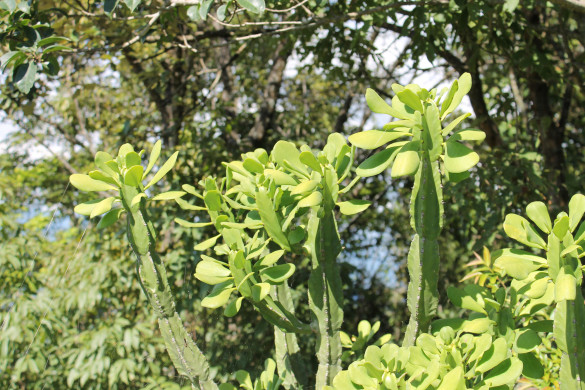
Euphorbia royleana
Types of Shilajit
The classical texts of Ayurveda such as the Bhavaprakasha state that there are four types of Shilajit, each with different properties. Each type is classified on the basis of its color, including red (sauvarna), yellow (rajata), blue (tamra), and black (lauha). All varieties of Shilajit are pungent (katu) and bitter (tikta) in flavor, but the red type has an additional sweet (madhura) flavor, whereas the black type has a salty (lavana) flavor. As for the energy, or virya, only the blue variety is considered warming in nature, whereas all the other types of Shilajit have a cooling (shita) energy.
Properties of Shilajit
In Ayurveda Shilajit is described as tridoshaghna, meaning that it reduces and balances all three doshas. It’s name literally means to ‘become like stone’, and it is believed that this same property of density, inertia, and hardness is manifested in the body when taken regularly. Shilajit is considered to be an important rasayana, or rejuvenative, used in the treatment of a wide number of health conditions, to prevent illness, and to ward off the effects of old age. According to an ancient physician of Ayurveda named Charaka, “there is no disease in the world that cannot be cured by Shilajit.”
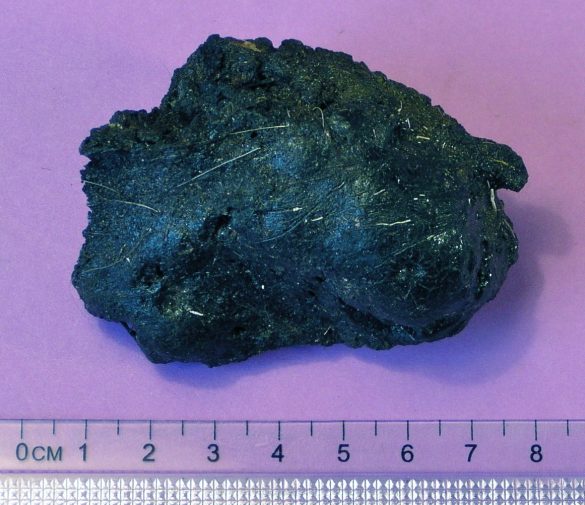
Raw, unprocessed Shilajit (origin: Nepal)
Therapeutic benefits of Shilajit
Shilajit is used as a kind of panacea in the treatment of a large range of health issues. It is used to enhance digestion and inhibit parasites, and helps to dispel mucus, resolve cough, and alleviate asthma. Shilajit also benefits the skin, resolves poisoning, enhances the intellect, boosts fertility, and ameliorates the effects of aging. Shilajit is perhaps best known as a treatment for madhu meha (diabetes mellitus), recommended by a 7th century text called the Ashtanga Hrdaya as a primary treatment for this condition, used along with a low-carbohydrate diet and rigorous exercise. By supporting pancreatic and kidney function, Shilajit is helpful to overcome any issue associated with insulin resistance, explaining why Shilajit has long been used in the treatment of weight loss and heart disease.
Shilajit is described as having a sandhaniya (healing) property in Ayurveda, and can be useful in any type of traumatic injury, including brain injury. Applied topically on unbroken skin, it helps to reduce inflammation and promote healing in bruises, sprains, and fractures, as well as reduce lymphatic swelling and alleviate arthritis. Given that its epithet means to “become like stone,” Shilajit has a particular affinity for the protective and structural tissues of the body, including the skin, hair, nails and bones, and can be very useful for issues including weak nails, hair loss, fragile skin, and osteoporosis. As a rasayana, Shilajit has a special ability to treat deficiency conditions, including infertility, weight loss, and aging. It also has an affinity for the nervous and immune systems, and is thus used in the treatment of mental disorders such anxiety, depression, psychosis and autism, as well as in the treatment of immunodeficiency conditions (e.g. HIV/AIDS) and cancer.
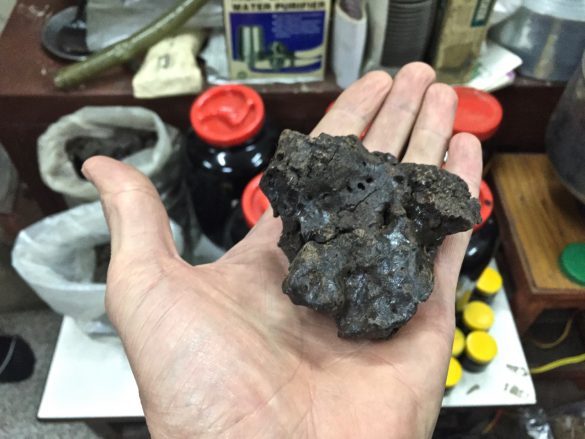
Raw, unprocessed Shilajit (origin: Nepal)
Medical research on Shilajit
The chemistry of Shilajit is highly variable depending upon the where it was collected and the processing methods utilized, which is another reason to distinguish Shilajit from substitutes such as mumiyo. Chemical research on crude Shilajit has demonstrated a variety of constituents, including both organic constituents (e.g. benzoic acid, hippuric acid, fatty acids, resins, waxes, gums, albuminoids and vegetable matter) and inorganic constituents (e.g. calcium, magnesium, potassium, silica). Raw, unprocessed Shilajit is comprised of up to 80% humus, which is mixture of decaying plant materials acted upon by bacteria and fungi, and thus contains high levels of both humic and fulvic acids. Further analysis of Shilajit has yielded the presence of biphenyl metabolites including a benzocoumarin and low molecular weight oxygenated dibenzo-α-pyrones, as well as triterpenes, phenolic lipids. Additional trace minerals have been isolated in Shilajit including antimony, cobalt, copper, iron, lithium, manganese, molybdenum, phosphorous, strontium, and zinc.
While Ayurveda has utilized Shilajit as a medicine for thousands of years, medical researchers are only now just beginning to scratch the surface of its therapeutic potential. Reflecting the traditional perspective that Shilajit ‘enhances cognition’ (medhya rasayana), medical research has validated the nootropic effects of Shilajit, as well its ability to attenuate addiction and withdrawal. Other research has similarly validated the use of Shilajit in the treatment of diabetes and cardiometabolic disorders, helping to reduce blood glucose, total cholesterol and triglyceride levels in treated patients, while significantly enhancing healthy HDL levels.
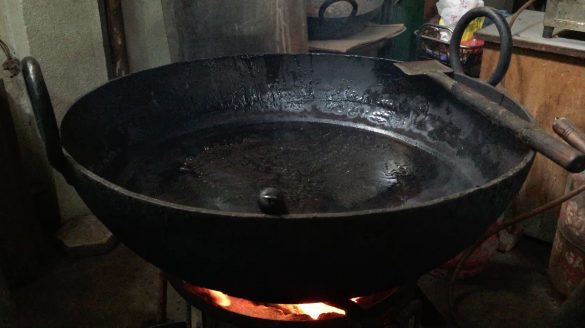
Purification of Shilajit (Nepal)
The best type of Shilajit
Tradition in India states that humans first became aware of the benefits of Shilajit by watching wild animals such as monkeys utilize it as a food source. While it is generally regarded as being quite safe, crude unprocessed Shilajit may contain mycotoxins from fungi such as Aspergillus niger, A. ochraceous, and Trichothecium roseum. Unprocessed Shilajit may also contain free radicals in the humic constituents that increase in concentration with an increasing pH, and thus certain sources of Shilajit that tends to have a higher pH, such as that obtained from Russia (i.e. mumiyo), may be a less desirable source.
As raw Shilajit is not considered fit for use in Ayurveda, a variety of processing techniques are utilized to both purify it and modify its therapeutic properties. Some of these processes take longer than others, and as a result there are more and less pure forms of Shilajit. According to tradition, the best way to purify Shilajit is the ‘surya tapi’ method, which harnesses the natural purifying power of the sun (surya), taking up to one year to prepare. This process involves decocting the powdered resin with the herbal formula Triphala, and then repeatedly exposing the filtered liquid to the rays of the sun over many months. Over time a scum forms on the surface of the liquid, and in the same way that cream is separated from milk, this is skimmed off and collected as the purified Shilajit.
While Shilajit is now catching on in the West as a kind of superfood, the sources I’ve seen online do not appear to undergo the same processing techniques described in Ayurveda, and thus cannot be considered authentic. Some products are standardized to the fulvic acid and dibenzo-α-pyrone content, which many researchers consider to be the active constituents of Shilajit. The problem with this assertion, however, is that both these chemicals are widespread in the soil, found as common metabolites derived from fungi, plants, and animal feces. Thus what is called “shilajit” in the marketplace could be just about anything that is rotting in the dirt! Attempts I have made to obtain information on how these various products are harvested and processed has yielded little fruit, and as such, I have long avoided recommending almost any Shilajit sold in the marketplace.
For several years now I have been working with the 800 year old Bajracharya medical lineage of Kathmandu, Nepal. With close access to the mountainous regions from which the raw Shilajit is harvested, these traditional physicians of Ayurveda have been producing the highest quality Shilajit for generations, observing not just its general benefits, but harnessing its therapeutic properties as well. Within Nepal and India itself, it is not too hard to find Shilajit, but rarely will the quality be all that good. As such, when I want to use Shilajit myself or for my patients, I make sure to get it direct from my sources in Nepal.
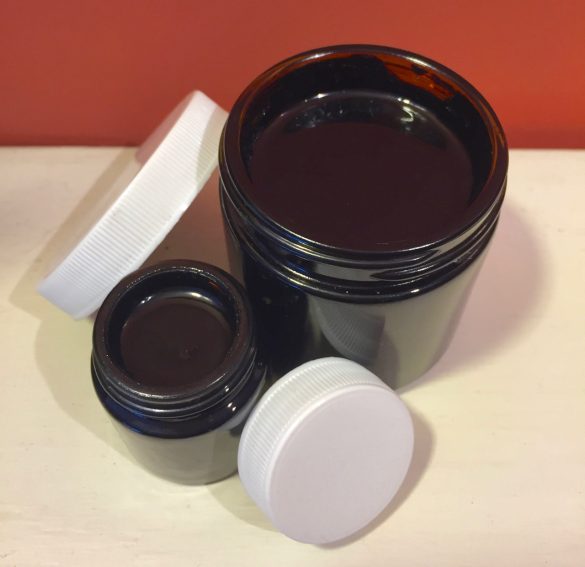
Purified ‘surya tapi’ Shilajit
For those of you keeping abreast of my activities over these last few months, you know that I recently returned from Nepal where I was leading a five week educational program (next trip tentatively planned for fall of 2018). Through my connections there I was able to obtain some high quality surya tapi Shilajit, which is the highest quality Shilajit available, and unlike any other product I have seen in the marketplace. The ‘vaidya’ or traditional doctor from whom I obtained this Shilajit actually prepares and exports relatively large amounts of Shilajit to the foreign market, but this material is processed much more quickly and doesn’t have the same level of purity. Prepared painstakingly over an entire year, he produces this surya tapi or ‘sun-purified’ Shilajit in much smaller batches, and only as a kind of hobby. I was fortunate to be able to bring back some of this surya tapi Shilajit, and now on a limited basis until I run out, I have decided to make some of it available for purchase.
To order this high quality surya tapi Shilajit, please use the payment widget below. If you can’t see the payment option below, please disable your ad-blocker and reload the page. All prices are in Canadian dollars.
NOTE: I am now all sold out. However, a couple of my American students purchased some Shilajit from the same batch, and if you’d like to order some, please contact them personally:
- Jason Scott: intrinsic.roots@gmail.com
- Daniel Boarman: daraboarman@gmail.com
